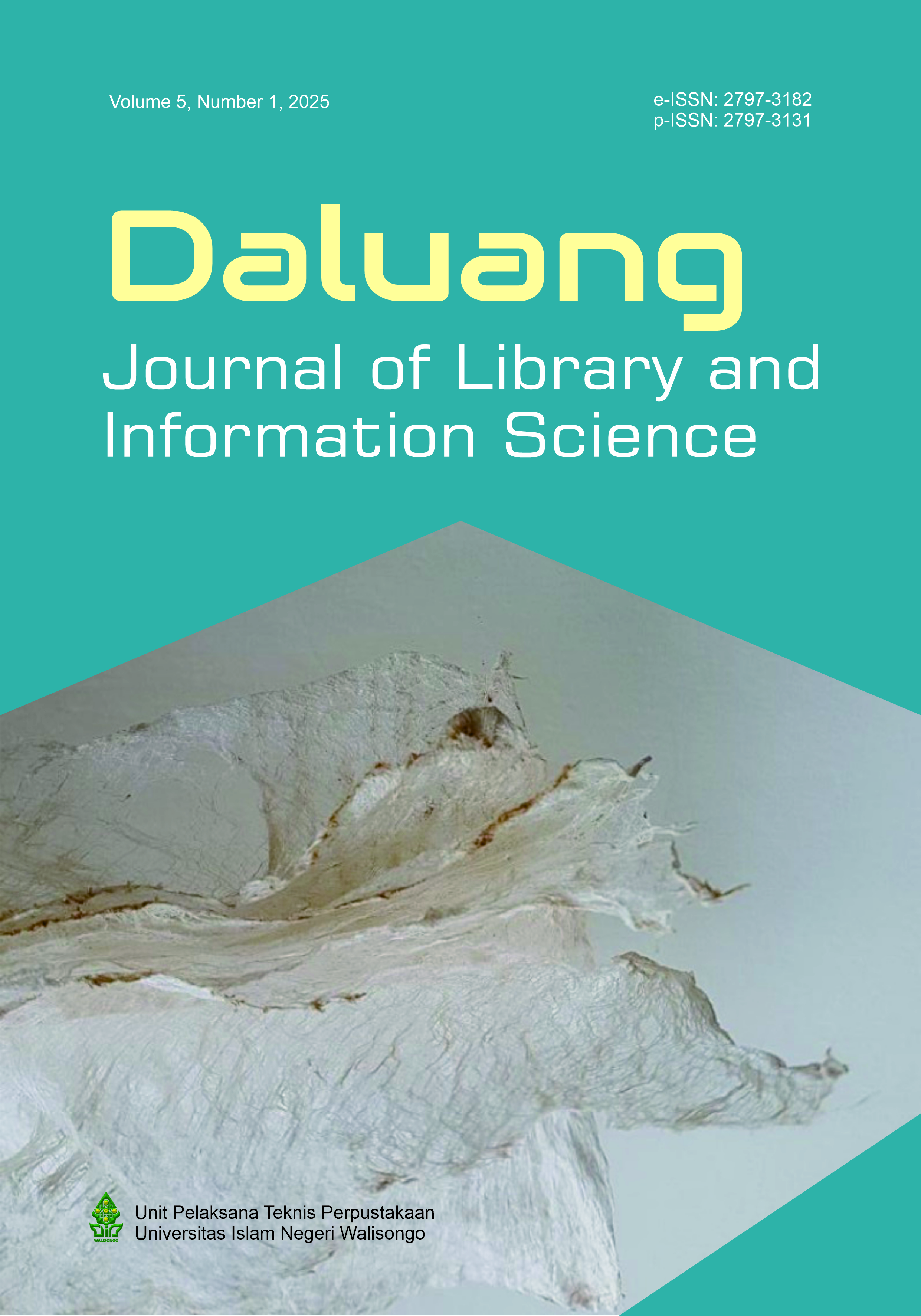Evaluasi fungsi kemas ulang informasi berbasis kecerdasan buatan di perpustakaan perguruan tinggi
Main Article Content
Abstract
Purpose. Artificial Intelligence (AI) holds great potential for repackaging information in academic libraries, particularly for historical physical collections. Each library must align its information management strategies with institutional development, as seen in the Library of Universitas 'Aisyiyah Yogyakarta (UNISA), which has evolved from a Midwifery School into a university. Two special collections in this library were evaluated to assess the effectiveness of AI-based information repackaging. This evaluation is important to ensure that resource utilization aligns with the outcomes achieved. The study aims to identify the functional value of AI-based repackaging for these collections.
Methodology. This descriptive qualitative study was conducted from September to October 2024 at the UNISA Yogyakarta Library. A purposive sampling method was used to obtain in-depth interviews from three informants based on their fields of expertise. Data were collected through observation and interviews. Data analysis included needs analysis, design proposal, data reduction, data presentation, and conclusion drawing. Data validity was tested using time triangulation and confirmability techniques.
Results and discussion. The results of the study show that most of the AI-based information repackaging functions at the UNISA Yogyakarta Library have fulfilled their functions. However, there is one function that has not been fulfilled, namely as a medium that accelerates the application of research or research results.
Conclusions. While the majority of AI-based information repackaging functions have been successful, efforts are still needed to enhance its role in disseminating and applying research results. Strategic development, inter-unit collaboration, and stronger technology integration are recommended to optimize these services.
Downloads
Article Details

This work is licensed under a Creative Commons Attribution-NonCommercial-NoDerivatives 4.0 International License.
This work is licensed under a Creative Commons Attribution-NonCommercial-NoDerivatives 4.0 International License.
Articles published in Daluang Journal of Library and information Science are available under Creative Commons Attribution Non-Commercial No Derivatives Licence (CC BY-NC-ND 4.0). Authors retain copyright in their work and grant Daluang Journal of Library and information Science right of first publication under CC BY-NC-ND 4.0. Users have the right to read, download, copy, distribute, print, search, or link to the full texts of articles in this journal, and to use them for any other lawful purpose.
Articles published in Daluang Journal of Library and information Science can be copied, communicated and shared in their published form for non-commercial purposes provided full attribution is given to the author and the journal. Authors are able to enter into separate, additional contractual arrangements for the non-exclusive distribution of the journal's published version of the work (e.g., post it to an institutional repository or publish it in a book), with an acknowledgment of its initial publication in this journal.
This copyright notice applies to articles published in Daluang Journal of Library and information Science volumes 1 onwards.
References
Adelia, N. (2022). Kemas ulang informasi dalam perspektif budaya informasi digital. Al-Ma’arif: Jurnal Ilmu Perpustakaan Dan Informasi Islam, 2(1), 121–133. https://www.rjfahuinib.org/index.php/almaarif/article/view/825/489
Aliwijaya, A. & H. C. S. (2023). Peluang implementasi artificial intelligence di perpustakaan: Kajian literatur. Info Bibliotheca: Jurnal Perpustakaan Dan Ilmu Informasi, 4(2), 1–17. https://doi.org/10.24036/ib.v4i2.397
Anna, N. E. V. and D. H. (2022). Aplikasi artificial intelligent untuk perpustakaan. Airlangga University Press. https://repository.unair.ac.id/120006/1/AI%20-%20Artificial%20Intelligence%20Di%20Perpustakaan_secure.pdf
Arikunto, S. (2013). Prosedur penelitian: Suatu pendekatan praktek (Cet.15). Rineka Cipta.
Dewi, A. O. P. (2020). Kecerdasan buatan sebagai konsep baru pada perpustakaan. Anuva: Jurnal Kajian Budaya, Perpustakaan, Dan Informasi, 4(4), 453–460. https://doi.org/10.14710/anuva.4.4.453-460
Dongardive, P. (2013). Information repackaging in library services. International Journal of Science and Research (IJSR), 2(11), 204–209. http://www.ijsr.net/archive/v2i11/MDIwMTM0MDM=.pdf
Fatmawati, E. (2022). Alih media digital dalam kegiatan pelestarian informasi. Al-Ma’arif: Jurnal Ilmu Perpustakaan Dan Informasi Islam, 2(1), 92–106.
Hasrawati. (2020). Analisis kemas ulang informasi menjadi koleksi digital di Dinas Perpustakaan dan Kearsipan Provinsi Sulawesi Selatan [UIN Alauddin Makasar]. https://repositori.uin-alauddin.ac.id/17957
Istiana, P., Prahatmaja, N., Dewi, Di. P., & Irkhamiyati. (2023). Prosiding seminar nasional inovasi & kreasi pengembangan perpustakaan berbasis ekosistem digital di era society 5.0. 1–252.
Jain, P. H., Kumar, V., Samuel, J., Singh, S., Mannepalli, A., & Anderson, R. (2023). Artificially intelligent readers: An adaptive framework for original handwritten numerical digits recognition with OCR methods. Information (Switzerland), 14(6), 14060305. https://doi.org/10.3390/info14060305
Jayanti, L. D., & Masruri, A. (2023). Kemas ulang informasi di Perpustakaan Universitas Respati Yogyakarta. Tik Ilmeu : Jurnal Ilmu Perpustakaan Dan Informasi, 7(2), 341. https://doi.org/10.29240/tik.v7i2.8609
Jody, S. (2021). Kemas ulang informasi koleksi perpustakaan sebagai upaya pemenuhan kebutuhan informasi para pemustaka. ABDI PUSTAKA: Jurnal Perpustakaan Dan Kearsipan, 1(2), 67–72. https://doi.org/10.24821/jap.v1i2.5955
Maharani, M., & Salim, T. A. (2024). Strategi pemerintah menggunakan AI: Studi kasus restorasi warisan budaya (koleksi foto prajurit) untuk peringatan 70 tahun gencatan senjata Korea Selatan Government strategies using AI : A case study of cultural heritage restoration (soldier photo collection) for South Korea ’ s 70th ceasefire commemoration. Jurnal Ilmu Informasi dan Perpustakaan, 15(2), 117–130. https://doi.org/10.20473/pjil.v15i2.65265
Nashihuddin, W. (2021). Strategi kemas ulang informasi untuk peningkatan pelayanan perpustakaan di era new normal. Jurnal Kajian Informasi & Perpustakaan, 9(1), 59-78. https://doi.org/10.24198/jkip.v9i1.28767
Pebrianti, Y. (2015). Kemas ulang informasi: Kumpulan karya tulis ilmiah peneliti. Jurnal Pari, 1(1), 27–33. http://dx.doi.org/10.15578/jp.v1i1.131
Prasetio, A., & Winanda, T. (2023). Dampak kecerdasan buatan (artificial intelligence) terhadap pemustaka dalam mencari informasi di UPT Perpustakaan Universitas Islam Negeri Raden Fatah. TADWIN: Jurnal Ilmu Perpustakaan Dan Informasi, 4(2), 79–85. https://doi.org/10.19109/tadwin.v4i2.20059
Shinta, C., & Rachman, M. A. (2020). Kemas ulang informasi sebagai upaya pemanfaatan informasi dan data di Perpustakaan Institut Pertanian Bogor. Bibliotech: Jurnal Ilmu Perpustakaan Dan Informasi, 5(1), 27–38. https://doi.org/10.33476/bibliotech.v5i1.1319
Tim Penyusun. (2023). Kamus Inggris-Indonesia. https://kamuslengkap.com/kamus/inggris-indonesia/arti-kata/connection
Vance AI. (2024). Ai old photo restoration. VanceAI Technology. https://vanceai.com/old-photo-restoration/
Wang, X., Li, L., Yuan, Y., Ye, P., & Wang, F.-Y. (2016). ACP-based social computing and parallel intelligence: Societies 5.0 and beyond. CAAI Transactions on Intelligence Technology, 1(4), 377–393. https://doi.org/10.1016/J.TRIT.2016.11.005
Wheatley, A., & Hervieux, S. (2020). Artificial Intelligence in academic libraries: An environmental scan. Information Services and Use, 39(4), 347–356. https://doi.org/10.3233/ISU-190065
Wijayanto, H., & Harsadi, P. (2021). Modul transformasi digital. STMIK Sinar Nusantara Surakarta. https://eprints.sinus.ac.id/780/1/Modul_Transformasi_Digital.pdf
Yusuf, A. M. (2014). Metode penelitian kuantitatif, kualitatif, dan penelitian gabungan. Prenada Media Grup.



